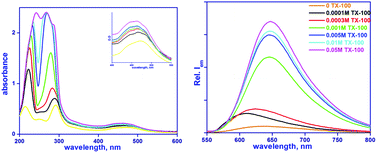Photophysical properties of amphiphilic ruthenium(ii) complexes in micelles†
Abstract
Amphiphilic ruthenium(II) complexes II–IV were synthesized and their photophysical properties were investigated in the presence of anionic (SDS), cationic (CTAB) and neutral (Triton X-100) micelles. The absorption and emission spectral data in the presence of micelles show that these Ru(II) complexes are incorporated in the micelles. There are two types of interaction between complexes I–IV and the micelles: hydrophobic and electrostatic. In the case of cationic micelles (CTAB), the hydrophobic interactions are predominant over electrostatic repulsion for the binding of cationic complexes II–IV with CTAB. In the case of anionic micelles (SDS), electrostatic interactions seem to be important in the binding of II–IV to SDS. Hydrophobic interactions play a dominant role in the binding of II–IV to the neutral micelles, Triton X-100. Based on the steady state and luminescence experiments, the enhancement of luminescence intensity and lifetime in the presence of micelles is due to the protection of the complexes from exposure to water in this environment.


 Please wait while we load your content...
Please wait while we load your content...